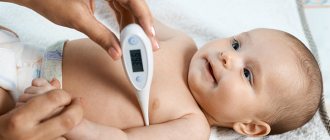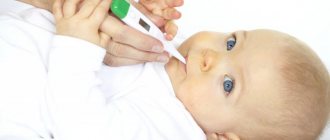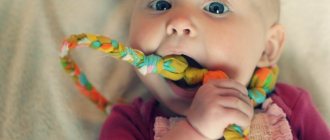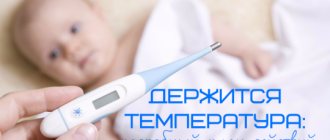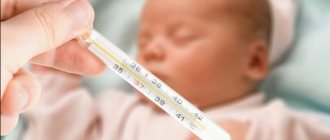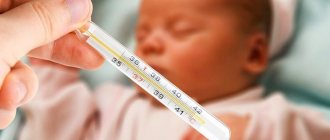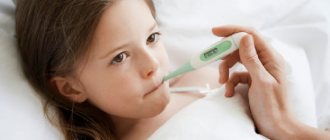Many parents wonder why their child has cold extremities during a cold. This is a pathological condition resulting from white fever. Unlike the body's normal reaction to a viral infection, in this case the blood rushes to the internal organs, bypassing the legs and arms. They become cold and may develop seizures due to lack of oxygen and glucose.
Causes of fever in a child
The body's heat balance is regulated by a special part of the brain called the hypothalamus. It is he, and not the bacteria and viruses themselves, that causes the temperature to rise so that the body begins to produce the substances required to fight the infection. This helps to cope with the disease as soon as possible.
If the temperature does not rise, interferon gamma will not be produced. The same can be said about the situation when it is artificially knocked down, preventing the activation of substances required to fight pathogenic microorganisms that cause the disease. This provokes disruption of the immune system, since the emerging interferon is necessary not only for the production of antibodies to viruses, but also for storing this in the immune memory.
The existing regulatory center is capable of setting the body’s permissible high temperature, which is required to destroy microorganisms and ensure the fastest possible recovery. The only thing is that if the child’s body overheats from the outside and if the center of self-regulation is disrupted (which is possible in the presence of brain tumors and as a result of traumatic brain injuries), the numbers can rise to unacceptable limits, but this is extremely rare.
Causes of cold hands
In addition to infectious diseases, an elevated body temperature in a child can also be observed due to overheating.
This phenomenon is observed when:
- excessive wrapping;
- long exposure to the sun;
- overheating of the room, etc.
In this case, the child’s temperature rises, but his hands remain cold. In particularly severe cases, nosebleeds, nausea and fainting may occur. In this case, cold hands are the main signal that vasospasm has begun.
In this case, you should immediately eliminate the factor causing overheating, give the child plenty to drink and apply a wet compress to the forehead.
It should be remembered that fever is a rather serious problem, as it causes undesirable processes in the child. For example, it increases the load on the heart and lungs, increases metabolism, leads to disruption of the nervous system, and others. Children under 1 year of age and infants are at particular risk.
The main clinical manifestations of classical conditions with increasing temperature
Feverish conditions can manifest themselves in different ways:
- A high body temperature, at which the skin is noticeably warm and red, is called “red” or “pink” fever, and, as a rule, the child feels more or less normal. The use of antipyretics in most of these cases is not required.
- A high temperature in a child and cold extremities indicate the manifestation of the so-called “white or pale fever,” which is accompanied by characteristic symptoms: increased pallor of the skin, chills, and a general serious condition. In this case, the use of antipyretics is justified, especially if hyperthermic syndrome is present.
Why is it extremely dangerous to rub a child with vodka or vinegar?
Speaking of high temperatures, we cannot help but talk about such an old method as rubbing the baby’s body with vodka or water and vinegar. It has long been believed that thanks to this procedure, the child’s heat transfer will increase and, as a result, the temperature will drop faster. And if, despite the fact that he has a high temperature, his hands are cold, then the vasospasm will be relieved safely. From a physics point of view, this is true. But we have a living baby in front of us, and therefore we must not forget about what exactly we rub on him.
The thing is that both vinegar and alcohol applied to children's skin are easily absorbed into the blood and because of this, alcohol poisoning occurs. And the drier and hotter the skin, the faster this happens. In addition, when wiping the child also inhales alcohol vapor, that is, poisoning also occurs through the respiratory tract. Therefore, the World Health Organization categorically does not recommend rubbing a child with vinegar or any alcohol-containing substances.
When to lower a child's body temperature
Modern pediatricians recommend taking antipyretics:
- When an absolutely healthy child without neurological problems, metabolic disorders (metabolism) and diseases of the cardiovascular system has a temperature of 39°C-39.5°C. In this case, you should focus on the general condition. If the child tolerates high readings well, it is possible and even necessary to allow even such numbers and not take anything for the temperature.
- Children in the first six months of life, as well as older children with additional health problems. In cases of poor health, the temperature is lowered to 38.5°C (with axillary measurement) or 38.9°C (with rectal measurement).
- If a child has a high fever and cold hands and feet, this indicates white fever. Taking antipyretic drugs is justified here. This must be done when the temperature reaches the first critical limits - 38.0-38.5 0C. Also in this case, you may need to take additional antihistamines and vasodilators, which should be checked with your doctor.
If the temperature is 37
It is believed that a child’s temperature should not exceed 36.6 degrees. But this indicator is somewhat arbitrary, since the temperature fluctuates throughout the day. For example, in the evening it rises by 0.5 degrees and this is considered normal.
You should start to worry if the thermometer reading exceeds the temperature of 37.5 degrees. This means that the body has turned on a protective mechanism against the influence of a variety of unfavorable factors.
To protect the body, the immune system begins to produce pyrogens that stimulate the production of prostaglandin E2. A number of rather complex reactions of the body are triggered, which lead to the fact that the body temperature begins to rise. Experts advise not to be afraid of temperature, as it protects the body from the destructive effects of invading foreign agents.
But not everyone tolerates an increase in body temperature well. This especially applies to children in the first year of life. A condition in which a child has a fever and has cold feet and hands requires special attention. In this condition, vasospasm occurs, which may be accompanied by febrile seizures.
This type of seizure occurs against the background of an increase in temperature (fever) in children whose age does not exceed 6 years. Experts believe that this is due to the predominance of excitation processes over inhibition in the brain, which leads to the emergence of pathological impulses in nerve cells. These processes can be caused by:
- infectious diseases;
- ARVI;
- vaccinations;
- hereditary predisposition.
As soon as the child turns 6 years old, the nervous system matures, such convulsions will pass, but vascular spasms may remain, during which the temperature should be reduced already at 37.5 degrees. Therefore, such children should be especially carefully monitored when the temperature rises.
What does a fever indicate against the background of cooling hands and feet?
If a child has a high temperature and cold extremities, while he cannot warm up, this indicates a failure of thermoregulation in the body. The cause is a spasm of peripheral blood vessels, which disrupts the process of heat transfer, which can even lead to convulsions. This condition can be explained by the well-known fact that at high temperatures the viscosity of the blood increases, thereby sharply slowing down its circulation through the vessels. This is typical if there are abnormalities in the functioning of the central nervous system in a child, with hypotension (low blood pressure) and as a result of non-compliance with the drinking regime, which leads to a lack of fluid in the body.
High temperature and cold feet, and often hands, are the first sign of incipient “white” fever. It is important to identify the symptoms in time and prevent possible negative consequences.
Causes of cold feet
If a child is sick, you should carefully monitor his skin and temperature not only of the head, but also of the whole body. You should never trust tactile sensations; if a child shows symptoms of deterioration in health, it is better to measure the temperature with a thermometer once again.
If, when examining a child, we find that the skin has become hot and moist, the color is rather pink (as if it is burning), then the child has red fever. It is characterized by maintaining a balance between heat generation and heat transfer.
In this case, it is necessary to give antipyretic drugs. Usually, with red fever, the temperature drops quite quickly, and the child's general behavior remains within normal limits.
Doctors diagnose white fever if, with an increase in temperature, the following are noted:
- dyspnea;
- chills;
- irregular pulse rhythm;
- delirium;
- pale, cold and dry skin;
- the child is very lethargic, sleepy;
- cold feet and hands with fever.
In this case, taking antipyretic drugs is prohibited, because it will not lead to the necessary reaction of the body (a decrease in temperature), but will only aggravate the condition and cause a sharp narrowing of blood vessels.
The main signs of "white" fever
This condition is characterized by the following symptoms:
- cold hands and feet;
- pronounced pallor of the skin, while the blueness of the lips and nails may be noticeable;
- chills (muscle tremors) even at high body temperatures, while the child complains that he is cold and cannot warm up even under a warm blanket;
- rapid heartbeat, possibly heavy rapid breathing;
- an increase in temperature to high values, which often does not respond well to antipyretic drugs;
- sometimes severe toxicosis is added (damage to the central nervous system, which is characterized by general weakness, lethargy, lethargy, or, on the contrary, anxiety, increased agitation, delirium, convulsions).
In what cases will emergency medical care be required?
Whether it is necessary to immediately consult a doctor, parents decide based on the child’s well-being and thermometer readings. But in some cases, it is better not to postpone consultation with a specialist. These include the following situations:
- The baby is not yet 3 months old, and his temperature has risen to 39°C.
- A child with a fever is very apathetic and lethargic: he refuses to drink, pees rarely, and his urine has become concentrated and dark yellow.
- A rise in temperature is accompanied by vomiting and diarrhea.
- The use of antipyretic procedures or drugs has no effect.
- The baby developed convulsions when he had a fever.
In all of these situations, medical attention is required. Do not hesitate to call an ambulance and follow the advice of doctors in the future.
What to do with high fever and cold extremities
If your child has obvious symptoms of white fever, you should:
- do not allow body temperature to exceed 38-38.5 ° C, measured in the armpit;
- call an ambulance;
- rub your arms and legs to stimulate blood flow to the extremities;
- warm up - wrap the child up, put on woolen socks, you can use a warm heating pad on the feet;
- regularly ventilate the room and maintain the air temperature in it no higher than 20°C;
- with the permission of the pediatrician, use “No-shpu” to dilate blood vessels;
- do not give strong antipyretics - this can increase the spasm, only ibuprofen and paracetamol for fever;
- ensure plenty of drinking - water, juices, fruit drinks, compotes (exclude tea, since it contains caffeine-like substances that increase urination, and this can lead to increased dehydration), and you need to drink little by little, but often.
First step: relieve the spasm
First you need to take medications that relax smooth muscles. The most commonly used tablets are “No Shpa” or “Drotaverine”. You can also insert one Papaverine suppository into the anus. It has a similar effect.
If you do not have such medicines on hand, then you need to warm your limbs yourself and increase blood flow in them. To do this, put warm socks on the patient and rub the feet. Some people use a variety of warming ointments. However, doctors strongly do not recommend doing this.
Why is high temperature dangerous?
With a fever, febrile seizures (seizures) may occur. They are most common in children of primary preschool age. It is necessary to take all measures to prevent this from happening. If this happens, you should:
- Place the child on his side on a hard surface, turning his head towards the floor. This will help prevent vomit or foreign objects from entering the respiratory system;
- pay attention that there are no sharp corners or dangerous objects nearby to avoid injury;
- in this case, for children with fever, use antipyretic suppositories - it is forbidden to pour medicine into the mouth so that the child does not choke or choke;
- Be sure to call emergency assistance.
Febrile seizures
Convulsions that appear against a background of high temperature are called febrile. Most often observed in children aged 3 months to 5 years, it is a condition that is directly related to age. Clinically uncomplicated febrile seizures manifest as generalized tonic-clonic seizures, the episode of which lasts about 15 minutes. The most typical development is at the peak of the temperature curve.
There are several theories regarding febrile seizures. It is believed that they can transform into an epileptic variant of seizures if they are repeated often enough and are pronounced. At the same time, there is an opinion that febrile seizures are not dangerous, since undesirable effects on the central nervous system are observed in very rare cases and they should not cause brain damage.
Despite the difference in assumptions, febrile seizures are usually benign and neurological damage is not to be feared.
Antipyretic drugs for children
If a child has a high temperature and cold extremities, even at 38.0°C, it is necessary to use special medications, for which the following can be used:
- paracetamol in the form of rectal suppositories from 3 months, according to research, it causes a minimal number of side effects;
- ibuprofen - it is allowed to be given to children from the age of six months, but according to pediatrician indications it can be used at an earlier stage (you should be aware that the drug can provoke hypothermia, cause inflammation of the stomach and is contraindicated for chickenpox and dehydration).
It must be remembered that the simultaneous use of these two drugs is unacceptable. Paracetamol for fever is used much more often, since its use is more convenient and possible in cases where the child refuses to take medications orally.
Also, for symptoms of “white” fever, it is sometimes possible to give children antispasmodics, which can help establish the natural process of sweating. To do this, take “No-shpa”, which promotes vasodilation. We must not forget that this drug has many contraindications, so the drug can only be used according to a doctor’s indications and in the permitted dosage.
Remember that if the disease is characterized by a high temperature in a child and cold extremities, then this is a mandatory reason to contact a specialist. In any case, children under one year of age require a pediatrician to be called home to make a correct diagnosis and exclude serious pathologies.
How to help your child
When parents discover cold extremities in a child with a fever, it is necessary to begin complex treatment at home with drugs from several categories:
- Antispasmodic: No-Spa, Drotaverine. They relax the smooth muscles of blood vessels, restoring natural blood flow. For convulsions, the dosage is increased to eliminate pathological contractions of skeletal muscles, hypoxia and microcirculation disorders.
- Antihistamines: Zodak, Suprastin. Relieves inflammation of the mucous membranes of the respiratory tract.
- Antipyretics: Panadol, Ibuprofen, Papaverine. They prevent the progression of pathology and restore blood flow to the extremities.
- Warming ointments: turpentine, Doctor Theiss, Pulmex baby, Mom. Stimulates blood flow to the hands and feet.
Antipyretics
Elevated temperature is +37.5…+38°C. This also applies to infants, whose normal values fluctuate between +37...+37.3°C. Unlike children over 1 year old, their temperature can be affected by external factors: weather, infections, air in the room. Symptoms of white hyperthermia develop at a high temperature in a child against the background of a violation of the thermoregulation process, when the skin on the hands and feet turns pale and becomes icy even in a hot room.
To solve the problem, antipyretics are used. You cannot leave the child’s immunity to cope on its own or give folk remedies. This doesn't help when viruses attack the hypothalamus in the brain. Drugs such as Ibuprofen (oral suspension and suppositories for topical use) and Papaverine (suppositories for rectal administration) can help prevent cramps and oxygen starvation of soft tissues.
These are universal products suitable for children of all ages. After 20 minutes, the child will begin to sweat, even if the skin was dry before.
For children over 3 years of age, you can use stronger drugs:
- Nurofen. An effective remedy for anaphylactic reactions to Paracetamol. Use 200 mg per day for a week if a high temperature develops.
- Paracetamol. Tablets that have a beneficial effect on the thermoregulation center in the brain. Up to 5 years of age, it is prescribed at a dosage of 100-150 mg per day.
- Panadol. Sweet syrup can be used from the first year of life, but in this case there will be a high risk of side effects. A single dosage is 15 mg per 1 kg of body weight. The course of therapy lasts from 5 to 7 days.
Antispasmodic drugs
Cold hands and feet in children against a background of high fever can be caused by vasospasm. The following drugs are used for treatment:
- Drotaverine. Restores the tone of vascular smooth muscles. Available in tablets. Allowed to use from 1 to 3 pcs. drug per day.
- No-Shpa. To obtain a quick effect, intramuscular injections are given. Restores blood circulation for 4-8 hours. If the condition is not severe, the drug is used in tablet form. The maximum daily dosage is 3 pcs. Treatment is carried out until the unpleasant symptom is eliminated.
For children from 5 to 12 years old, antispasmodics are recommended to be used together with Papaverine. The suppositories are placed half an hour after taking the first dose of the drug. The rectal remedy enhances the effect of the medication. Combining medications for children aged 1 to 5 years is not recommended, so as not to cause an overdose or side effects.
Application of lytic mixture
Lytic mixtures are prescribed when a child develops symptoms of a cold fever. The preparations contain several active components, which:
- normalize metabolism;
- relieve pain;
- relieve arterial spasm;
- reduce temperature;
- improve blood supply to tissues in the extremities.
Medicines are used only when the child’s condition is serious, as they have a toxic effect on the liver and create a burden on the kidneys. Lytic mixtures are often used during resuscitation efforts. Injections are placed into the gluteal muscle to achieve a quick therapeutic effect.
You can prepare this remedy at home if you have the necessary medical skills:
- Take 1 ml of Diphenhydramine, No-Shpy, Analgin and mix in a syringe.
- Inject the solution into the outer upper sector of the gluteal or femoral muscle.
- Monitor the child's condition.
Improvement occurs within 5-10 minutes. Using the product is often strictly prohibited. With prolonged use of lytic mixtures, the body quickly gets used to the drugs, so they become ineffective. The combined remedy is used in extreme cases when there is a risk of seizures and hypoxia.
Rubbing and warming the extremities, drinking plenty of fluids and other methods
When parents notice cold hands and feet when their child has a fever, the following recommendations should be followed:
- Warm the child by placing a warm heating pad under the limbs. It is covered with a blanket and woolen and cotton socks are put on. The baby also needs warm clothes. It is better to hold a child under one year old. An adult's warmth will warm him up faster. In case of dehydration and a temperature above +38°C, the child, on the contrary, is stripped down to his underwear, so as not to harm the brain. They give an antipyretic.
- You can use warming turpentine ointment to rub the limbs. After applying the product, put socks on your feet.
- Give your child plenty of liquid at room temperature. This allows you to artificially increase the pressure in the vessels and restore normal blood circulation. Breasts are offered to drink mother's milk, which contains antibodies.
- It is allowed to reduce the air temperature in the room to +18…+20°C. At the same time, there should be no drafts in the room, which can aggravate the course of the cold. If the child is under one year old, a hat is placed on his head. You can open windows and doors in other rooms without blocking the air flow to the room with the sick child.
- Additionally, carry out wet cleaning of the room. If it's winter outside, you should hang wet things on the radiators. Flowers are watered abundantly. This artificially increases the humidity in the room. If there is a humidifier, be sure to turn it on.
- After completion of all manipulations, the temperature is measured. Don't worry if your readings remain high even after taking medications. The therapeutic effect of drugs can be obtained within 20-30 minutes after their use.
When a child has a high temperature, it is not recommended to apply a wet compress to the forehead. NSAIDs are considered ineffective for the treatment of white hyperthermia and should not be used.
